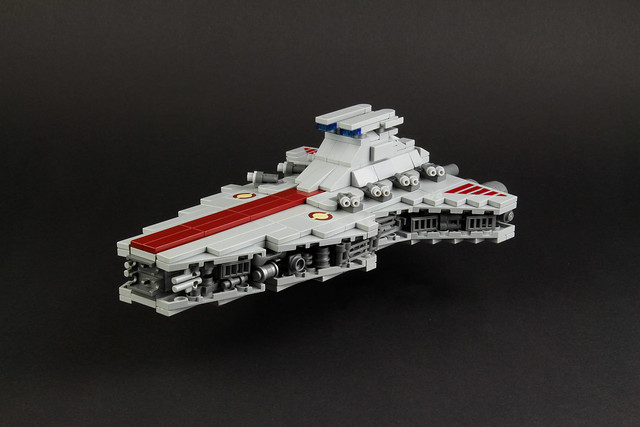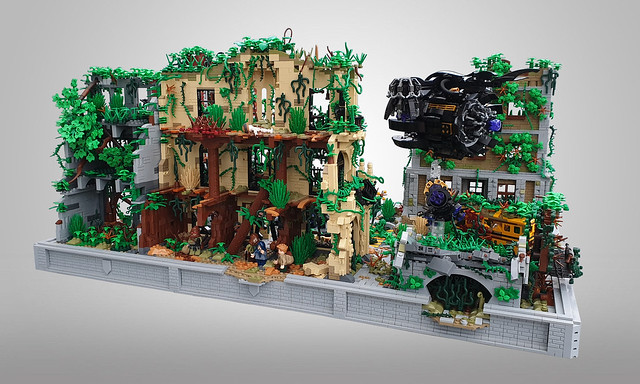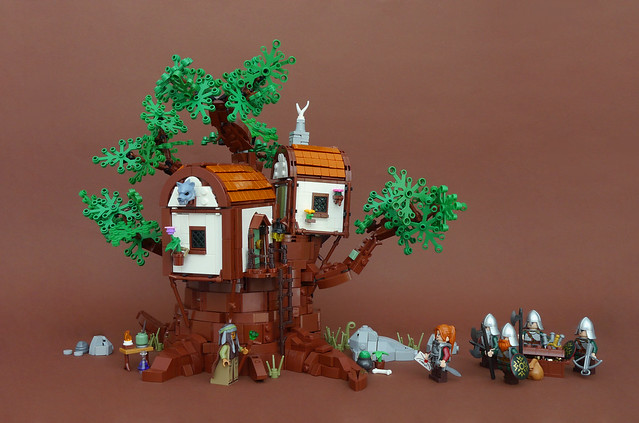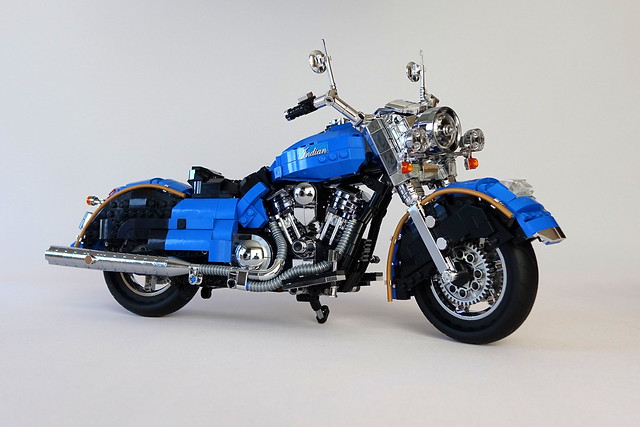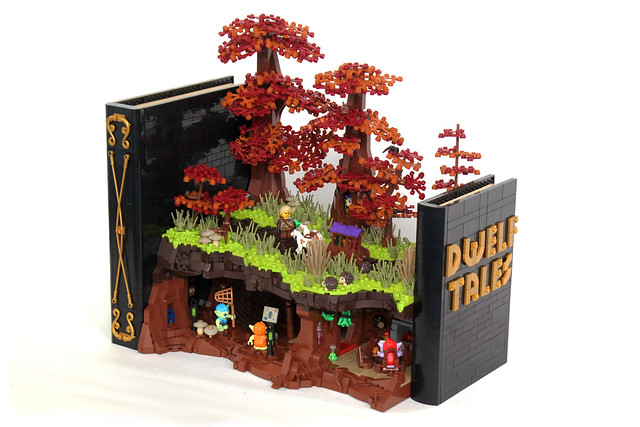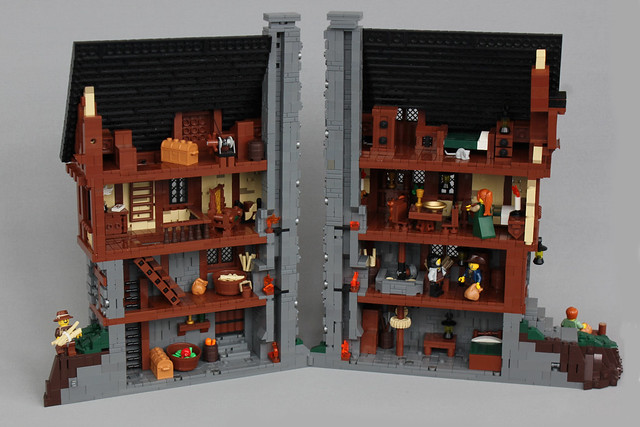I admit it. I love the prequel trilogy of Star Wars movies. It is not for the scintillating dialogue or the powerful acting, though, impressive as those are. No, it is for the cool spaceships and the deeper look at life in the galaxy. There’s more to the thousands of planets than a few military bases and super-weapons, after all. One of those cool spaceships is the Venator-class Star Destroyer, used by the Republic. Fans of LEGO have been clamoring for years for a UCS (Ultimate Collectors Series) model of the ship, and, quite frankly, I’ll be surprised if they ever get it due to an anti-prequel bias. For now, though, they can be content with seeing this microscale version built by Stephan Niehoff. It’s got everything it needs: blasters, thrusters, greebles, and most importantly, the dual bridges and the dark red stripe along the top. Now it’s time to take out some Separatists!
Posts by Benjamin Stenlund
Neo-Classic Space rock(et)s!
I’m too young to have played with Classic Space sets or figures firsthand, so I don’t have the nostalgia that many fans of LEGO feel. I caught the tail end of Futuron and grew up a die-hard fan of Blacktron II. That being said, my uncle had a bunch of the original spacemen and I enjoyed playing with them whenever I went to my grandparents’ house. And today, as an adult, I love the simple color scheme and the almost whimsical design of the old sets, and even more the highly detailed and almost absurdly greebled Neo-Classic Space creations. This rover by billyburg hits a sweet spot; it’s not too greebled, but also not too studded (or studded at all). It is an homage to 6950 Mobile Rocket Transport, but with two rockets and a much different scale. This one is for tiny spacemen! The knobby tires look great and the metal detectors make for a nice sensor array in the front. Time to get exploring.
You can’t take kids anywhere these days
Ruins are hard to do convincingly in LEGO form. I think this is partly to do with the rigid grid of the brick, which does not lend itself to organic shapes of decay, and partly to do with the visual incoherence that often results from too many shapes and colors in the same visual field. Even though we are a far cry from the primary/white/black color days at the dawn of the LEGO brick, there is still a limit to the shades and hues that can be used to differentiate areas of a build and maintain something that still makes sense to the brain. That being said, this post-apocalyptic build by Peter Ilmrud does a good job of showing buildings that look both coherent and ruined, covered with verdant vegetation, while a menacing black ship prowls air above the streets.
I’m fairly certain that nearly every botanical element produced by LEGO appears in the build somewhere, from vines to leaves to leafy vines to seaweed and more. Even the sprues from the three-leaved plants appear as vines. It is a lush city. The bad guys (you can tell they’re bad because they wear black) are aliens trying to kill the humans to harvest natural resources (like Avatar in reverse), and their ships are filled with greebles, especially ones from the Batman pack. Of course, with evil aliens on the prowl, one of the poor kids has lost his teddy bear crossing a street. Kids, I tell you what. Good thing they’re cute.
A cottage among the leaves
LEGO is an art form. It requires precision placement of elements, meticulous thought, endless creativity, and a bold sense of the possibilities. Sure, you can build like a four-year-old, placing stuff willy-nilly and using any old color you please. You can also color on walls like a four-year-old, but that doesn’t take away from the frescoes of Raphael or Michelangelo. A build like this one by Marcel V. illustrates my point. There is a balance of composition, the cohesion of form, careful use of colors, and especially crisp photography. This is no child’s toy anymore.
This is not the first time I have written about a treehouse by Marcel, but this one has glorious limbs and even more glorious little rooms. The cheese slope roof looks great, and if you look close, every potted plant is constructed and attached differently. Don’t miss the book as a little roof over the door, too. My favorite detail might be the small table at the base of the tree, built of a combination of sorcery and twigs. The little pebbles arranged so carefully, stalks of grass, and even the soldiers posed loose give the build a much larger feel while still exhibiting a mastery of brick composition. After all, LEGO is an art form.
Red looks good on more than just Ferraris
When I was a kid, I collected lots of Hot Wheels and Matchbox diecast cars. Somehow or other, among them all, I ended up with three red Lamborghini Countaches, all identical. I just had them out the other day, looking at them with my son, in fact, driving at insane speeds around the coffee table and eventually plunging over the edge in a fiery wreck. I also recently purchased the new Ferrari F8 Tributo, and noticed that the new windscreen looked a lot like the Hot Wheels Countach’s shape. It seems I am not the only one, as super car LEGO builder Jonathan Elliott used that very piece to create his own 7-stud wide take on the Countach LP400, and did it immeasurably better than I could have.
The signature triangular scoops in the sides are done perfectly, and the angular hood and body, which ushered in a new era of sharply angled supercars, replicate the original’s nearly spot on. I wish this version had the huge V-shaped wing on the back that later models (including my Hot Wheels) had to add control to the car at high speeds. Sure, the wing decreased the top speed a bit, but the car handled better with it when pushing its upper limits. But that’s minor. The 7-stud body is a nice compromise between the too-small 6-wide and the too-large 8-wide, too. I’m not sure if it fits a minifig, but does it have to when it looks this nice?
Wait, a not-grey Star Wars spaceship?
I love the LAAT gunship from Star Wars, so when I saw it was a candidate for an upcoming UCS set I was thrilled. Better known as the Republic Gunship, it is probably my favorite Clone Wars ship. It has great blasters, a refreshingly not-grey color scheme, an interesting shape, cool doors on the sides; it’s essentially a cross between a UH-1 Huey, an A-10 Warthog, and a spaceship. And I love it. This rendition by Thomas Jenkins is awesome, with elegant curves and smoothly-transitioned angles. Because that’s the trick with the LAAT; there are so many different curves and angles that fitting them all in while maintaining a solid model is exceedingly difficult. But this one succeeds, and even appears to include Jedi Bob.
Modified bricks with curved tops make for some smooth curves, improving the square edges of all the official LEGO renditions. Also a major improvement is how Thomas made the wings and doors of bricks rather than plates; this allows them to be smooth and solid without needing a ton of tiles, which always looks a bit off due to the slightly rounded edges of tiles. The interior looks smooth, too, and big enough for minifigs without being excessively large. If LEGO does release a UCS version of this ship, I hope the designers borrow some design elements from models like this one. I would buy one in a heartbeat. Did I mention I love it?
Check out this incredibly huge and detailed LEGO diorama of the Eternal City, Rome
It is rare for a LEGO build to make my jaw drop and leave me drooling on my keyboard, but that is just what this stunning layout of Imperial Rome by Rocco Buttliere did. I have a Master’s degree in Classics, primarily in the Latin language, and so anything and everything Roman is right up my via, but there is a lot of great information to learn in the descriptions of the photos, even for one with an advanced degree in a tangential field. In fact, I could spend hours looking through all the pictures, and have already spent the better part of one skimming through the descriptions. It is fascinating stuff. And the build! It is huge, about 1×2 meters in size, with 66,000 bricks going into its construction. And not one is wasted or superfluous. So let’s take a brief tour of the Eternal City, shall we?
See more of this masterpiece of LEGO architecture
She’s got it where it counts, kid
Is there a spaceship as universally beloved as the Millennium Falcon? Maybe the Enterprise is close, but then you get into a debate about which Enterprise is beloved, since numerous ships have held the moniker. But there is only one Falcon (even if it’s had a few changes). Maybe it’s the way it looks like a pile of garbage, or a rusty bucket of bolts, the kind of ship that leaves you saying, “Hear me, baby, hold together” whenever you hit a bump, just like the first car you bought in high school. It’s even got those stupid dice hanging from the rearview mirror, and you gotta believe Han’s got a few of those pine tree-shaped air fresheners hung up around the ship. Seeing her fly, somehow, despite being anti-aerodynamic, through the atmosphere, trailing a pretty blue jetstream – magic. Andreas Lenander captures a bit of that feel with his latest LEGO build, showing the Millennium Falcon blasting out of some hive of scum and villainy or other.
It is at a smaller scale, so naturally quite a bit of detail is lost, like the proper number and positioning of the heat exhaust vents on the back or the exposed access hatches on the front mandibles. But who cares when the glowing blue trail is so perfect? The greebles are nicely executed, with a nice assortment of parts, including handcuffs and stickers from one of the official sets. And the city down below looks appropriate for the universe without being tied down to any particular locale. I love the use of the microfighter Falcon’s cockpit cone for a building’s windows. But that LED-lit blue trail is the highlight, fit for the fastest ship in the galaxy, capable of making 0.5 past light speed.
A perfect meld of classic design with modern performance
Indian Motorcycle is one of the most iconic brands of two-wheeled road machines out there. It may not have the same name recognition today as Harley-Davidson, but it is the first American motorcycle company (beating H-D by two years) and had an amazing peak before going bankrupt in 1953. The trademark bounced around for a while before being bought up by Polaris Industries, famous for their snowmobiles and other recreational vehicles, and today Indian Motorcycles are going strong and cruising the open roads once more. Henrik Jensen brings the Chief Classic, a bike with old-school looks but modern technology, to life in LEGO bricks, with a two-tone blue-and-black colorway and lots of beautiful sparkly chrome. The trademark bulky fenders are lovingly rendered in brick form, and I can practically hear the throaty roar shaking that tailpipe. Who wants to do some cruising?
Goblins and dwelfs, oh my!
Most adult builders looked at the little goblin figures from LEGO’s Elves theme with some distaste. I suspect this was due to the bright colors and limited elements that make them up. I know I felt that way. They are difficult to fit into a build, even a fantasy one, because they are too cartoonish to be taken seriously. Given the right setting, though, perhaps they could be useful. Take, for instance, this build by John Snyder. Bright colors, like lime green grass and a purple wagon roof, tie the goblins and their garish hues into the overall build. The layout itself is unique, with large brick-built tomes bookending the multi-level scene. Plus, as always with a Snyder build, there are play functions. The small dwarf-elf (or dwelf, as the cover implies) is in trouble, about to fall through a trapdoor into the subterranean lair of the goblins. Could anything be worse than being captured by those almost-useless rainbow-colored creatures?
Oh, truck yeah!
Some LEGO builds look like they are made from tiny studded pieces of plastic. That’s appropriate, because that is what they are. However, some builds are done so sleekly that nary a stud is showing, save for representation of a specific detail. These builds cause the viewer to do a double take, and this author has been known to utter a muffled “holy bleep, that’s LEGO” from time to time when seeing them. This truck by Dennis Bosman is one such build. It’s a refrigerated Volvo F12 truck, branded for the Stie’s Termo Transport company from Norway. It is way too big for minifigs (it’s 1:13 scale, as opposed to roughly 1:25-1:42 for minifigs, depending on the relevant dimensions), and scaling it that way allowed Bosman to include mind-boggling details. The cab lifts open to reveal a fully equipped engine, the cab is plushly furnished, the trailers are studded both inside and out, and even the refrigeration units on the trailers have motors inside them.
Click to see this truck in greater detail
Just milling around
When I think back to the LEGO sets I loved most as a kid, two come to mind: 6075 Wolfpack Tower and 6048 Majisto’s Magical Workshop. What made them special? Well, perhaps it was the opening functions they both had, so that I could have both a fully-enclosed building and a fully-accessible interior for my characters to live in. That, and I loved both wolves and dragons, so they had cool shields. Some castle builders (myself included) generally just build an interior room or exterior tower or wall from a particular angle, with a rainbow of parts behind the scenes. It saves time and bricks to do so. But when Isaac Snyder constructs a building out of LEGO, 99 times out of 100 it includes a full interior. Every part of the build is playable, accessible, and carefully thought through. It is like the sets of my childhood, only a billion times cooler and more detailed.
I adore roofs made from cheese slopes, and surprisingly for someone as prolific in the castle genre as Isaac, this is his first use of the technique. The chairs on the waterwheel look perfect, and everything has the polished Snyderian look one expects from Isaac; nothing seems out of place. Inside the structure, several things stand out, the first being that every level is accessible via a ladder or stair, with specific holes in the floor to move minifigures around. Kid me would have had a heyday making characters go up and down the stairs, falling through the holes, and so on. Second, there are beds and other practical furniture, which castle sets seldom had. Friends sets do, but not castle. Third, and perhaps most excitingly, the mill really spins! The gears connect to the grindstone, so you can make your very own ABS flour. Play functions and aesthetics. What more could one want?
